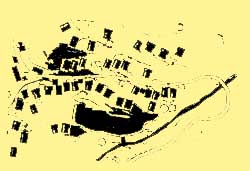
. . . the fundamental unit of organization within the neighborhood - IDENTIFlABLE NEIGHBORHOOD (14) - is the cluster of a dozen houses. By varying the density and composition of different clusters, this pattern may also help to generate DENSITY RINGS (29), HOUSEHOLD MIX (35), and DEGREES OF PUBLICNESS (36).

People will not feel comfortable in their houses unless a group of houses forms a cluster, with the public land between them jointly owned by all the householders.
Therefore:
Arrange houses to form very rough, but identifiable clusters of 8 to 12 households around some common land and paths. Arrange the clusters so that anyone can walk through them, without feeling like a trespasser.


A cluster of 12 houses.
In existing neighborhoods of free-standing houses, the pattern must be brought into play gradually by relaxing zoning ordinances, and allowing people to gradually knit together clusters out of the existing grid - see COMMON LAND (67) and THE FAMILY (75). It is even possible to implement the pattern with ROW HOUSES (38) and HOUSING HILLS (39). In this case the configuration of the rows, and the wings of the apartment building, form the cluster.
In all cases common land which is shared by the cluster is an essential ingredient. It acts as a focus and physically knits the group together. This common land can be as small as a path or as large as a green.
On the other hand, care must be taken not to make the clusters too tight or self-contained, so that they exclude the larger community or seem too constricting and claustrophobic. There needs to be some open endedness and overlapping among clusters.

Overlapping clusters in a Turkish village.
Along with the shape of the cluster, the way in which it is owned is critical. If the pattern of ownership is not in accord with the physical properties of the cluster, the pattern will not take hold. Very simply, the cluster must be owned and maintained by its constituent households. The households must be able to organize themselves as a corporation, capable of owning all the common land they share. There are many examples of tiny, user-owned housing corporations such as this. We know several places in our region where such experiments are under way, and places where they have been established for many years. And we have heard, from visitors to the Center, of similar developments in various parts of the world.
We advocate a system of ownership where the deed to one home carries with it part ownership in the cluster to which the home belongs; and ideally, this in turn carries with it part owner ship in the neighborhood made up of several clusters. In this way, every owner is automatically a shareholder in several levels of public land. And each level, beginning with the homes in their clusters, is a political unit with the power to control the processes of its own growth and repair.
Under such a system, the housing, whether in low or high depsity neighborhoods, can gradually find its way toward an abiding expression of the cluster. And the clusters themselves will come to support a quality of neighborhood life that, from our broken down neighborhoods now, we can only dimly perceive.
The unavowed secret of man is that he wants to be confirmed in his being and his existence by his fellow men and that he wishes them to make it possible for him to confirm them, and . . . not merely in the family, in the party assembly or in the public house, but also in the course of neighborly encounters, perhaps when he or the other steps out of the door of his house or to the window of his house and the greeting with which they greet each other will be accompanied by a glance of well-wishing, a glance in which curiosity, mistrust, and routine will have been overcome by a mutual sympathy: the one gives the other to understand that he affirms his presence. This is the indispensable minimum of humanity. (Martin Buber, Gleanings, New York: Simon and Schuster, 1969, p. 94.)

Use this pattern as it is for low densities, up to about 15 houses per acre; at higher densities, modify the cluster with the additional structure given by ROW HOUSES (38) or HOUSING HILL (39). Always provide common land between the houses - COMMON L.AND (67) and a shared common workshop - HOME WORKSHOP (57) . Arrange paths clearly - CIRCULATION REALMS (98) - and lay these paths out in such a way that they create busier paths and backwaters, even within the cluster - DEGREES OF PUBLICNESS (36); keep parking in SMALL PARKING LOTS (103), and make the houses in the cluster suit the households which will live there - THE FAMILY (75), HOUSE FOR A SMALL FAMILY (76), HOUSE FOR A COUPLE (77) HOUSE FOR ONE PERSON (78), YOUR OWN HOME (79). . . .